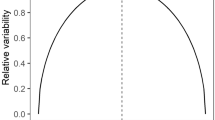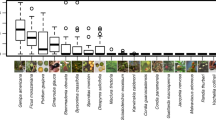Abstract
EVIDENCE I acquired during an experiment on the evolution of Batesian mimicry indicated that under some circumstances birds can detect quinine dihydrochloride on flour–lard pastry baits. The results of some previous mimicry experiments1–5, in which pastry baits were presented to wild birds, may need to be re-evaluated because of their tacit assumption that birds can only detect by taste the quinine used to make the models unpalatable. Quinine salts used were the hydrochloride2,3 or dihydrochloride1,5. Pilecki and O'Donald's “solution of quinine”4 was presumably quinine hydrochloride, which they used previously. Quinine monohydrochloride has only 1:16 solubility6, so Morrell and Turner2 probably used the more soluble dihydrochloride to make their 75% solution. Birds in an experiment of Ikin and Turner1 took nearly as many perfect mimics of two different models as palatable controls, though very few models (70% quinine) were taken. These authors suggested that birds in previous experiments2,5 may have distinguished “models from ‘perfect’ mimics, possibly because the quinine causes a slight yellowing of the pastry”. So far as I can determine, however, a specific control for detection of quinine has never been conducted.
This is a preview of subscription content, access via your institution
Access options
Subscribe to this journal
Receive 51 print issues and online access
$199.00 per year
only $3.90 per issue
Buy this article
- Purchase on Springer Link
- Instant access to full article PDF
Prices may be subject to local taxes which are calculated during checkout
Similar content being viewed by others
References
Ikin, M., and Turner, J. R. G., Nature, 239, 525–527 (1972).
Morrell, G. M., and Turner, J. R. G., Behaviour, 36, 116–130 (1970).
O'Donald, P., and Pilecki, C., Evolution, 24, 395–401 (1970).
Pilecki, C., and O'Donald, P., Evolution, 25, 365–370 (1971).
Lea, R. G., and Turner, J. R. G., Behaviour, 42, 131–151 (1972).
Sollman, T., A Manual of Pharmacology and its Applications to Therapeutics and Toxicology, eighth ed. (Saunders, Philadelphia, London, 1957).
Nur, U., Am. Nat., 104, 477–486 (1970).
Alcock, J., Behaviour, 40, 1–9 (1971).
Alcock, J., Anim. Behav., 18, 592–599 (1970).
Grant, C., Condor, 47, 261–263 (1945).
Rothschild, M., and Kellett, D. N., J. Entomol, A46, 103–110 (1972).
Author information
Authors and Affiliations
Rights and permissions
About this article
Cite this article
TERHUNE, E. Wild birds detect quinine on artificial Batesian models. Nature 259, 561–563 (1976). https://doi.org/10.1038/259561b0
Received:
Accepted:
Issue Date:
DOI: https://doi.org/10.1038/259561b0
Comments
By submitting a comment you agree to abide by our Terms and Community Guidelines. If you find something abusive or that does not comply with our terms or guidelines please flag it as inappropriate.



